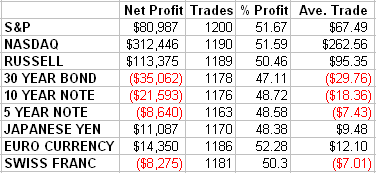Sometimes, as they say, it's as plain as the nose on your face.
We showed that if the last two open-to-closes point in the same direction, that's a fade. Also, the first basic trading building block we cited was an old tendency for markets to rise following a down day and fall after an up day. That bias was actually pronounced enough for me to include it in my book from 2000, Market Rap: The Odyssey of A Still-Struggling Commodity Trader.
Alas, five years later, the new data banks weren't as co-operative. (Proof once again that markets do drift). If anything, recent times have seen it become an anti-rule.
But with just the slightest adjustment, we're back in the bias pronouncement business. Again, as the two open-to-close idea showed, it's not so much the relation of the close to the previous close that's significant. It's whether or not the close was up or down relative to the opening. It's a fade idea for one day also. If yesterday's close-to-open was down, be a buyer on today's open and vice versa for short sales. Exit on the close.

It's a pretty persistent indicator for the indexes and currencies, as you can see. Unfortunately, it blows up in the bonds. Sometimes you just can't get all those Rubik's Cube sides to mesh.
Tomorrow, we'll look at another simple variation that will expand the positive results across the entire field.
Art Collins is the author of Market Beaters, a collection of interviews with renowned mechanical traders. He is currently working on a second volume. E-mail Art at artcollins@ameritech.net.